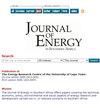Sustainable energy supply and business collaborations for sustainability, resilience and competitiveness in the Zambian copper industry after Covid-19
IF 0.6
4区 工程技术
Q4 ENERGY & FUELS
引用次数: 0
Abstract
The mining industry in Zambia is energy-intensive, with hydro energy providing the required energy But other sources of energy may need to be added, because hydro energy is subject to good rain patterns, threatened by the spectre of climate change, as already indicated by the current prolonged hours of load shedding by state-owned, Zambia Electricity Supply Company This research looks at state-of-art mining technologies and collaborative business processes that leverage on the expected ramp in copper and cobalt (Cu-Co) global demand post-Covid-19, to help design resilient business systems by manufacturing, source goods and services within the Southern African Development Community (SADC) region to lower Cu-Co production costs, and maximise profits through shared resources and bilateral trade agreements With evidence, projection and predictions by global leaders in the Cu-Co industry, this study evaluates the preparedness and resilience of the Zambian mining industry for sustainable energy supply, environmental sustainability, and suggests some possible business collaborations within the SADC region to share the following resources: metal refineries, transportation of goods and services, expertise and energy supplies within SADC, to enhance business sustainability The study shows that the resilience of Cu-Co business in resource-rich nations like Zambia is complex and is heavily influenced by investment decisions, stakeholder interests, copper ore grades and extractive process types, reliable power supply, and socio-economic and political issues The significance of this study is that it proposes some business collaborations within SADC that can increase energy reliability and supply, Cu-Co production, increase business resilience, improve global competitiveness and sustainability by exploring energy efficiency and generation-mix strategy可持续能源供应和商业合作促进新冠疫情后赞比亚铜行业的可持续性、韧性和竞争力
赞比亚的采矿业是能源密集型产业,水能提供所需的能源,但可能需要增加其他能源,因为水能受制于良好的降雨模式,受到气候变化幽灵的威胁,正如目前国有电力公司长期断电所表明的那样。本研究着眼于最先进的采矿技术和协作业务流程,利用2019冠状病毒病后铜和钴(Cu-Co)全球需求的预期增长,帮助设计有弹性的业务系统,在南部非洲发展共同体(SADC)地区采购商品和服务,降低Cu-Co生产成本,并通过共享资源和双边贸易协定实现利润最大化。根据全球铜钴行业领导者的预测和预测,本研究评估了赞比亚采矿业对可持续能源供应和环境可持续性的准备和恢复能力,并建议南部非洲发展共同体区域内一些可能的商业合作,以共享以下资源:研究表明,在赞比亚等资源丰富的国家,铜钴业务的弹性是复杂的,受到投资决策、利益相关者利益、铜矿石等级和提取工艺类型、可靠的电力供应、本研究的意义在于,它提出了南部非洲发展共同体内部的一些商业合作,可以通过探索能源效率和发电组合战略来提高能源可靠性和供应、铜钴生产、增强商业弹性、提高全球竞争力和可持续性
本文章由计算机程序翻译,如有差异,请以英文原文为准。
求助全文
约1分钟内获得全文
求助全文
来源期刊

Journal of Energy in Southern Africa
ENERGY & FUELS-
CiteScore
3.00
自引率
0.00%
发文量
16
审稿时长
6 months
期刊介绍:
The journal has a regional focus on southern Africa. Manuscripts that are accepted for consideration to publish in the journal must address energy issues in southern Africa or have a clear component relevant to southern Africa, including research that was set-up or designed in the region. The southern African region is considered to be constituted by the following fifteen (15) countries: Angola, Botswana, Democratic Republic of Congo, Lesotho, Malawi, Madagascar, Mauritius, Mozambique, Namibia, Seychelles, South Africa, Swaziland, Tanzania, Zambia and Zimbabwe.
Within this broad field of energy research, topics of particular interest include energy efficiency, modelling, renewable energy, poverty, sustainable development, climate change mitigation, energy security, energy policy, energy governance, markets, technology and innovation.
 求助内容:
求助内容: 应助结果提醒方式:
应助结果提醒方式:


